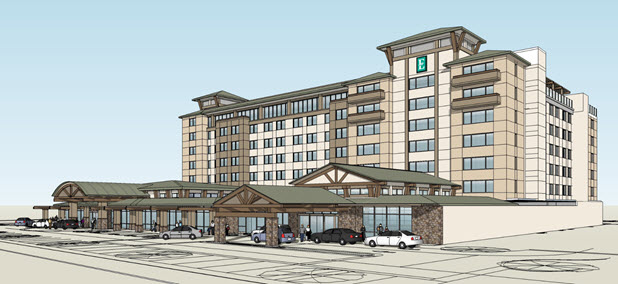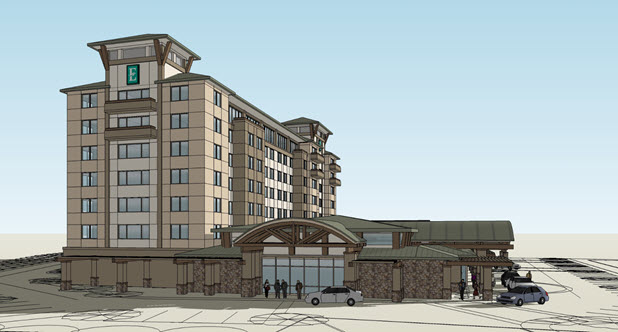
On Thursday, the Vanguard learned that earlier in the week, a formal planning application has been submitted for the Richards Hotel/Conference Center at 1111 Richards Blvd. The project proposes a seven-story hotel and conference center on roughly 2.82 acres that are located at the site where the University Inn and Suites as well as Caffe Italia currently rest.
City Community Development & Sustainability Director Mike Webb confirmed this, noting that the applicants are the current property owners, Ashok and Ken Patel.
“The project would replace the existing single-story 43 room University Inn and Suites Hotel with a new seven-story 120 room hotel including a 3,000 square foot restaurant and 14,700 square foot conference center,” Mr. Webb stated.
In addition to the hotel building, a two-level parking garage with 119 spaces is proposed along Olive Drive, plus 53 surface spaces for a total of 172 parking spaces. A pool, new landscaping and site improvements are also proposed. Site improvements would include parking, circulation, landscaping and utilities.
“The proposal requires a CUP [conditional use permit], Zoning Amendment, General Plan and Specific Plan Amendment, and Design Review,” Mr. Webb continued. “The project will require review by the Planning Commission and City Council.”
Back in 2012, the city of Davis prioritized the remainder of its RDA funding to build a Hotel-Conference center with the hopes of attracting critical tax revenues as well as attracting out-of-town conferences and further economic development, as the city and university look to remake the area from Nishi to Olive Drive.
The city is looking toward the Transient Occupancy Tax as a way to boost revenue.
In March 2011, “the Redevelopment Agency issued $4 million in taxable bonds to support a hotel conference facility. The bond proceeds, plus approximately $6.5 million in fund balance, are potentially available to assist this project.”
The original plan was for the city to buy the building, remodel and then lease it to Caffe Italia. RDA was to pay for up to $990,000 and the project could run as high as $1.4 million.
Under the plan, Caffe Italia would have to move to a new location as the Embassy Suites would take up the entire footprint of the site.
At the time, when the Redevelopment Agency was still around, the city believed that the hotel conference facility could generate around $100,000 in new property taxes to the RDA while it generated a whopping $350,000 per year to the Transit Occupancy Tax.
However, on Thursday, Mike Webb told the Vanguard, “we really do not know what, if any, funds will be available.”
He added that the applicant “is aware that at this point, they cannot count on any RDA funds.”
Davis Chief Innovation Officer Rob White told the Vanguard, “This is one of several catalyst efforts for our downtown core and will significantly enhance the Davis tourism and hospitality offerings.”
“It has been well understood for some time that we are losing overnight guests to Sacramento and we need to provide more lodging options to retain the tech, research, and academic travelers. And the conference center will help to fill a gap in available meeting space in the community and create opportunities to host larger events in Davis. All of these result in increased activity in our downtown shops and restaurants and revenue to our community,” he added.
An email to Ashok Patel was not returned to the Vanguard on Thursday.
Below are photos of the proposal:
—David M. Greenwald reporting



David wrote:
> The city is looking toward the Transient Occupancy Tax (TOT)
> as a way to boost revenue.
Does anyone know if the city gets TOT tax from the (recently expanded) Hyatt Place Hotel (on campus next to the Mondavi Center)?
SOD – I asked that question before and I think the answer is no because it is a university property on university property.
In general, I like this hotel idea. Davis needs more hotel space and this is a reasonable location. But I have one question… why do we put all of our hotels right next to the railroad tracks and freeway? When I have business associates and clients visit they stay in either the Hallmark or the UCD Hyatt and they all complain about being awaken at night by the sound and rumble of trains and the beginning of rush hour traffic. I suppose there are no other easy options given the layout of the town.
The obvious issue with this concept is auto, pedestrian and bike access and flow to and from downtown. I will study the proposal.
My guess is that hotels prefer to be next to the freeway, for visibility reasons . My guess is that don’t have the same preference when it comes to railroad tracks, but in our towns case they come tougher.
>When I have business associates and clients visit they stay in either the Hallmark or the UCD Hyatt and they all complain about being awaken at night by the sound and rumble of trains and the beginning of rush hour traffic.
Do you then hand them the world’s smallest violin to play?
No that’s a campus location. That’s a chief reason the city is building one of their own.
Anyone feel like explaining what exactly RDA funding is and where it comes from, and save me the internet research?
Redevelopment Funding was largely disbanded by Jerry Brown two years ago. Basically there was an increment of property taxes that got siphoned away from the state and went to local agencies in a defined spacial boundary known as a the redevelopment area, where the city could designate areas of the city as “blight” or needing improvement. In Davis that area was the core and portions of south Davis. The key was that the city could take a much larger portion of property taxes than they get from elsewhere keep it in a fund and use it to fund projects. The city also used a portion to pass through to the county in exchange for the county not developing in Davis’ sphere of influence – that was known as the pass-through agreement.
It wasn’t siphoned away from the state. It was siphoned away from other agencies such as school districts. The state then made up that difference (“backfilled”) the lost taxes to the school districts. The state was paying the schools the money that cities were taking from property taxes via RDA assessments. Also important to note: RDA funds could only (in theory) be used within the RDA assessment district. So the Davis RDA was roughly South Davis + downtown. South Davis property tax monies were being used to fund downtown projects. It was all supposed to be used to improve “blighted” areas, but the definition of “blight” has become broad enough to cover just about anything.
The fact that the pass-through agreement funds to the county got accepted as coming from a redevelopment district comprised of South Davis and downtown demonstrates how convoluted the whole thing had become. But in fact, it was the pass-through agreement, resulting from the Ramos-induced Mace Ranch development, that was the impetus for the whole redevelopment district in the first place. Mayor Rosenberg and the others were simply finding a way to prevent further peripheral development being forced on the city of Davis by developers working in collusion with the cash-strapped county.
Rich Rifkin knows a whole lot more about this, and wrote a detailed column on it a couple of years ago. So I fully accept any corrections or amendments to my summary that he might provide.
Yes Michelle, Rich Rifkin has great knowledge of matters like this and can give you his truthful and informational insight.
Michelle thinks my intentions are bad, and that I am out to mislead.
My take is slightly different from Don’s 9:47 am post. But, insofar as we disagree, it is more a matter of opinion than on the facts.
I think, at least in the case of Davis, the RDA was good. It kept more tax money paid by Davis property owners in the hands of the city of Davis (doing business as the DRDA). Indirectly, however, all RDAs harmed funding for the schools, under the Prop 98 funding formula. The RDA formula made all local agencies, other than the schools, 100% whole.
By the way … what really has hurt the various local agency districts–like our library district and flood control district and mosquito abatement, and Yolo County, etc–is the ERAF. That has taken millions of dollars from local governments, giving all the money to the school districts.
As Lois Wolk could tell you, the ERAF was a big power grab by the CTA. Well, she might not to you. But she told me that directly.
Ah, yes, the ERAF. My thought at the time was that it was just a Rube Goldberg scheme for keeping funding going to the schools. I only saw the state’s role there as being the transfer agency. But then once the implementation got put into place it likely had winners and losers. Here’s a good overview: http://www.mikemcmahon.info/ERAFOverview.pdf
I think the RDA funds were used for many beneficial projects in Davis, and other cities, and also grossly misused for projects in other cities. My main point is that as we enter an era of serious fiscal insolvency, having a separate fund for those kinds of projects means they get prioritized inappropriately. Also, the voters and taxpayers don’t, IMO, get the kind of oversight and public input for RDA projects (even though the RDA board is just the city council) that they get for projects that go through the usual budget process. To simplify: if we’re laying off tree workers and closing swimming pools, do the citizens really want to spend money to beautify the downtown?
Also, having the funding separated in that manner really invited abuse, crony developer relationships, and a serious lack of oversight. The state controller’s report was very damning.
Don: This is a bunch of useless chatter that does not really do anything but prevent you from admitting that Governor Brown killed a useful and valuable mechanism for helping communities stay vital through redevelopment.
This statement To simplify: if we’re laying off tree workers and closing swimming pools, do the citizens really want to spend money to beautify the downtown? demonstrates perfectly that you are taking the left ideological path and ignoring the long-term community benefits from a more vital and economically healthy community resulting from redevelopment.
I see the lack of redevelopment as being one primary cause of us needing to lay off city workers and cut services… now and certainly in the future.
Sorry I wasted your time. Anytime you want to have an actual conversation, let me know.
Meanwhile, here’s some reading material from a right-wing organization about the abuses of eminent domain (200+ and counting) used in redevelopment projects across California. http://castlecoalition.org/images/publications/californiaschemingfinal.pdf
Yeah – right wingers and libertarians like me don’t like the abuses from eminent domain. However, again you pull out the extremes to justify the plug being pulled. It is a large dose of hypocrisy coming from you since you demand such a nuanced approach for everything else you care about.
The schools have some crappy teachers, so why not do away with the entire education system?
You absolutely know that there was not any problem with RDA that could not have been fixed with legislation and rules. It is, in fact, a deflection of responsibility for the outright theft that our governor pulled off to pay off his political debt.
Your conservative credentials are rapidly fraying over this issue. You’re really just a crony capitalist, apparently. Tax dollars are great if they’re being used to seize land so developers can make money. But if money is going to the hobgoblin union members, then it’s theft. Got it.
The driving concept behind the formation of RDAs was that communities had limited ability to restore or increase the vitality of neighborhoods or parcels where there was not enough private investment and/or coordination to do so. The key was to improve the area so property values increased. The incremental increase in property tax revenue that occurred would be used to both fund the bonds used to finance the redevelopment, and also to give to local governments which would mostly go to the schools.
RDAs worked very well for most communities… turning otherwise unproductive property into value-added development that help improve the vitality of the community. Downtown Winters is a great example how RDAs added tremendous value to a community.
But the state did not share in that tax increment. And as the state committed more to state workers and entitlements than were were taking in, the deficits started putting pressure on school funding. So governor Brown basically raided the RDA cookie jar to help it appear that he was a big fiscal conservative helping to balance the state budget. Since now the local schools would get ALL that incremental tax revenue increase derived from the work of the RDAs, the teacher unions would be gleeful, and then the state could give more to the state worker unions because of the reduced pressure for school funding from the state.
It was basically theft. And the loser was/is communities that need to do any redevelopment. And that also means fewer jobs. That is something that state and national Democrats are really good at these days… destroying opportunities to produce jobs.
From the Legislative Analyst’s Office:
So your analysis is completely incorrect. Or the LAO is. I’ll let someone else referee this.
Don, read what I wrote again. The Governor raided the cookie jar to direct the property tax revenue from the RDAs to the local schools (primarily) so that there would be less pressure on the state to make up the shortfalls. And so it was a slight of hand move that kept more money at the state. I did not write that any property tax money went to the state directly. But it does not matter.
It was a win, win for all the public sector unions and their members… and the governor was their hero for doing it.
Even as he put another nail in the coffin of state and local economic development.
plus side: big, attractive building that can furnish the city with badly needed revenue.
down side:
seven stories? at the edge of an incline no less?
location? richards is a mess already. olive is a disaster.
roll out? we’re doing gateway-nishi-olive-richards-hotel conference all at once???
so while i like it in concept, i have a lot of thinking to do.
I believe there is discussion under way about adding an additional pedestrian crossing under the railroad tracks, as well as some other improvements to that downtown entrance that would encourage more pedestrian traffic.
That portion in South Davis may be my property, it defiantly qualifies as a “blight” at times.
Can modern double-pane or triple-pane windows, and extra noise barriers (sound proofing, mature trees), significantly reduce the sound of the freeway and railroad? In the grand scope of things, that added design feature might be just a modest cost increase. (I once stayed in an old hotel in downtown Rome that had TWO sets of double-pane windows, with a foot gap in between, and we heard nothing when the windows were closed.)
Could they please add more warmth to the lobby area, and maybe a local Davis twist?
The architectural renderings don’t show how it would fit in with its surroundings. In the images the building is just plopped down on Tatooine – beige flat surroundings in all directions. Perhaps this is normal and it’s because the surroundings are the city’s responsibility and not the developers’. But still, it would be very useful to see the proposed building in relation to the buildings around it to give a sense of just how dominating it is/isn’t.
my exact concern as well – don’t know how this will fit in with the surrounding area.
It appears from the picture that the proposal includes bulldozing all of Olive Drive and Davis and replacing everything with a sterile flat earth. The obvious dodge at showing how the facility will fit in with the surrounding businesses is troubling. We all KNOW what an F-ing Embassy Suites looks like. Most pictures may be worth a thousand words . . . this one is not.
LOL! Alan, you are a hoot.
So now the act of grading the land for development is an environment tragedy!? So is the natural grade of the land a natural resource that we must protect?
“bulldozing all of Olive Drive and Davis.”
Would you admit to that being a large bit of hyperbole?
Alan C. Miller engage in hperbole? I don’t even know what the word means.
LOL! I don’t either! 🙂
Here is the most important question, how easy will it be to sneak into the bar during complimentary happy hour?
As DP noted, traffic is a big concern in that area. I’d like to see the traffic circulation plan, but the city’s website is worthless for finding anything. Anyone have a link they can share?